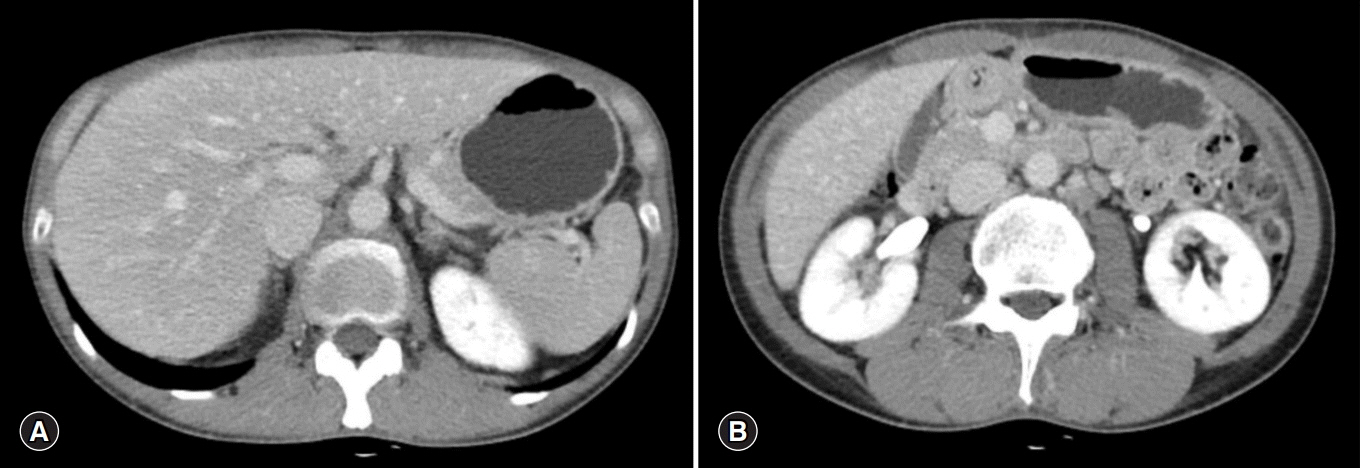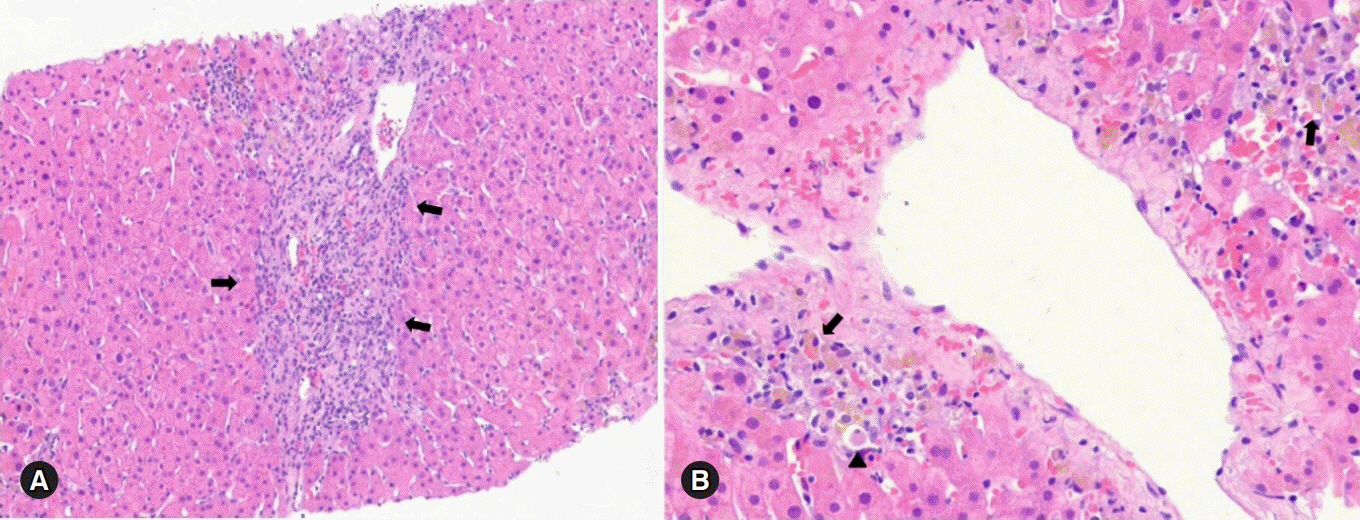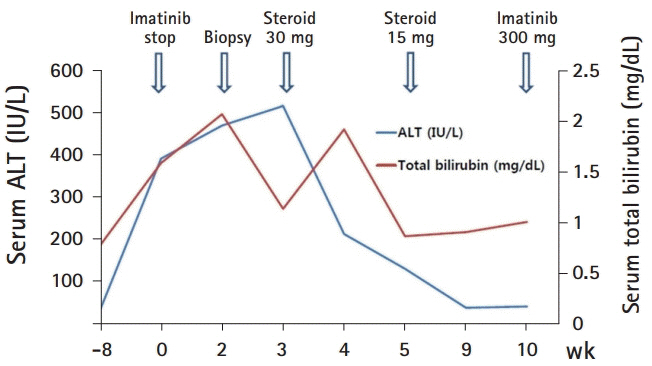Yeungnam Univ J Med.
2019 May;36(2):155-158. 10.12701/yujm.2019.00115.
Imatinib-induced hepatitis treated by corticosteroids in a patient with metastatic gastrointestinal stromal tumor
- Affiliations
-
- 1Department of Internal Medicine, Yeungnam University College of Medicine, Daegu, Korea. kmggood111@naver.com
- 2Department of Pathology, Yeungnam University College of Medicine, Daegu, Korea.
- KMID: 2449330
- DOI: http://doi.org/10.12701/yujm.2019.00115
Abstract
- Imatinib mesylate is currently used as the first-line treatment for metastatic gastrointestinal stromal tumors (GISTs). Imatinib-induced hepatotoxicity in patients with GIST is very rare. Its features vary from subclinical elevation of serum aminotransferase to clinically apparent acute hepatitis, which is associated with immunologic reactions. Imatinib-induced hepatotoxicity with autoimmune-like features can be treated by the discontinuation of imatinib mesylate and the administration of oral steroids. Here, we report a case of late-onset imatinib-induced hepatitis with autoimmune-like features in a patient with metastatic GIST, which was improved by oral corticosteroids.
Keyword
MeSH Terms
Figure
Reference
-
References
1. Pariente A, Etcharry F, Cales V, Laborde Y, Ferrari S, Biour M. Imatinib mesylate-induced acute hepatitis in a patient treated for gastrointestinal stromal tumour. Eur J Gastroenterol Hepatol. 2006; 18:785–7.
Article2. Tonyali O, Coskun U, Yildiz R, Karakan T, Demirci U, Akyurek N, et al. Imatinib mesylate-induced acute liver failure in a patient with gastrointestinal stromal tumors. Med Oncol. 2010; 27:768–73.
Article3. Seidel C, Fenner M, Länger F, Bantel H, Ganser A, Grünwald V. Imatinib-induced liver cirrhosis in a patient with advanced gastrointestinal stroma tumor (GIST). BMC Cancer. 2012; 12:186.
Article4. Yachoui R. Early onset imatinib mesylate-induced hepatotoxicity in a patient with gastrointestinal stromal tumors. Am J Ther. 2014; 21:e148–50.
Article5. Ferrero D, Pogliani EM, Rege-Cambrin G, Fava C, Mattioli G, Dellacasa C, et al. Corticosteroids can reverse severe imatinib-induced hepatotoxicity. Haematologica. 2006; 91(6 Suppl):ECR27.6. Al Sobhi E, Zahrani Z, Zevallos E, Zuraiki A. Imatinib-induced immune hepatitis: case report and literature review. Hematology. 2007; 12:49–53.
Article7. Guilhot F. Indications for imatinib mesylate therapy and clinical management. Oncologist. 2004; 9:271–81.
Article8. Sharma A, Houshyar R, Bhosale P, Choi JI, Gulati R, Lall C. Chemotherapy induced liver abnormalities: an imaging perspective. Clin Mol Hepatol. 2014; 20:317–26.
Article9. Joensuu H, Trent JC, Reichardt P. Practical management of tyrosine kinase inhibitor-associated side effects in GIST. Cancer Treat Rev. 2011; 37:75–88.
Article10. Almazroo OA, Miah MK, Venkataramanan R. Drug Metabolism in the Liver. Clin Liver Dis. 2017; 21:1–20.
Article11. Döring B, Petzinger E. Phase 0 and phase III transport in various organs: combined concept of phases in xenobiotic transport and metabolism. Drug Metab Rev. 2014; 46:261–82.
Article12. Willson TM, Kliewer SA. PXR, CAR and drug metabolism. Nat Rev Drug Discov. 2002; 1:259–66.
Article13. Hunt CM, Papay JI, Stanulovic V, Regev A. Drug rechallenge following drug-induced liver injury. Hepatology. 2017; 66:646–54.
Article14. Saif MW, Smith MH, Maloney A, Diasio RB. Imatinib-induced hyperbilirubinemia with UGT1A1 (*28) promoter polymorphism: first case series in patients with gastrointestinal stromal tumor. Ann Gastroenterol. 2016; 29:551–6.
Article
- Full Text Links
- Actions
-
Cited
- CITED
-
- Close
- Share
- Similar articles
-
- Imatinib-induced DRESS Syndrome in Gastrointestinal Stromal Tumor
- Metastatic Cutaneous Duodenal Gastrointestinal Stromal Tumor: A Possible Clue to Multiple Metastases
- Postoperative Cure for Metastatic Gastrointestinal Stromal Tumor
- Two different KIT mutations may lead to different responses to imatinib in metastatic gastrointestinal stromal tumor
- Successful Resection of Locally Advanced Gastrointestinal Stromal Tumor of the Ampulla of Vater after Treatment with Imatinib




